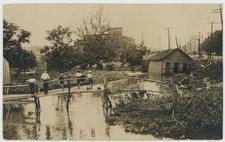Jordan Valley Beautification
 "With the beginning of a campaign for the beautifying of the Jordan Valley, old citizens of Springfield are taken back to the time when it was a clear little stream where the folk of years ago were want to spend their evenings in the shade of the trees that line its banks, and the children to play and fish.
"With the beginning of a campaign for the beautifying of the Jordan Valley, old citizens of Springfield are taken back to the time when it was a clear little stream where the folk of years ago were want to spend their evenings in the shade of the trees that line its banks, and the children to play and fish.
"'Jordan', is only a nickname given by the boys of Springfield about the time of the Civil War. It really is Wilson Creek, named after a man by that name who was an early settler and probably the first storekeeper in the town. The day the town received the name of Springfield, Wilson, who was a storekeeper in Delaware Town, near the mouth of Finley Creek, brought a tent here and opened a store where the Union National Bank now stands [southeast corner of the square]. The store consisted of one barrel of 'good' white whiskey and a few bolts of domestic [fabric].
"He called the few voters into his tent and showed them that he had a keg of whiskey on tap with a wooden faucet in it. He told them he was born and reared in Springfield, Mass., a beautiful little town, and that it would gratify him very much if they would vote to name this town Springfield. But whether or not they did, he told them, the keg of whiskey was on tap and they could have all the toddies they cared for. They voted to name the town Springfield.
"L.A. Rountree, afterwards a captain in the Federal Army, suggested that they name the creek which flowed through the village Wilson Creek in honor of the man with the liquor. Wilson Creek rises on the farm owned and occupied for a great many years by Captain James Massey [east of Glenstone near Barnes], who served in the war of 1812. It originates about three and one-half miles east of Springfield. It enters the city limits near Delaware Avenue and the Division Street Road, flowing southwesterly through the city, and passes out at the southwestern limits near Mt. Vernon Street and Kansas Avenue.
"The stream is fed by several springs, among which are those on the farms formerly owned by Ephriam Massey, Thomas Layton, later a member of the firm of Layton, Jones and Company, and Major D.D. Berry and the Fulbright Spring. Fulbright Spring was noted in the infancy of the city for the great number of baptizing which took place there, practically all being held in it.
"Martin J. Hubble, one of the old settlers of the city, having come here in 1856, in relating some of the old history connected with the 'Jordan,' told of Jacob Painter, the first gunsmith in Springfield, who would sit on the banks of the creek and fish for several hours at a time. 'But,' Mr. Hubble said, 'he was never known to catch a fish longer than two or three inches.'
"'I remember at one time,' he said, 'when Lem Bigbee swam a horse from where Gottfried's store now stands [322-326 Boonville] to Pine Street [now Tampa Street], where a Mr. Jenkins had a blacksmith shop. Heavy rains had made it a small river.'
"The first tan yard in Springfield was built in the valley of Wilson Creek close to Mill and Boonville Streets. Captain A.M. Julian had a wool carding machine where Meyer's Mill now is [northeast corner of Phelps & Boonville], and it is said to have been the first manufacturing establishment here. Captain Eb Smith had a planing mill on the east side of Boonville Street, just north of Meyer's Mill. A foundry was built and operated by Holcomb and Thompson near where the brewery now stands. During the Civil War the federal soldiers took charge of it and there moulded their bullets, which were used in the fighting in the vicinity of Springfield.
"The war put the creek in the condition it now is. The soldiers utilized it by throwing tin cans and all kinds of debris in it and this has continued to the present day. Where one time it was lined with beautiful trees and garden spots of those residing along its banks, it was changed to a muddy, murky stream, filled with all kinds of refuse.
"Then the valley ranged in width from fifty to five hundred feet and was the pride of the town. Now it is an eye-sore and the citizens have awakened to the fact that it must be cleaned."
Republican, May 2, 1915
While Wilson may have had a store near the mouth of the Finley River, Delaware Town was located near the mouth of Wilson's Creek on the James River. According to the History of Greene County 1883, in 1865 Holcomb & Thompson rebuilt their foundry at the intersection of 'Jordan' and Campbell. An 1884 Sanborn Fire Insurance Map shows a business called the Springfield Iron Foundry on the northeast corner of Campbell and Mill Streets. The image above is an undated postcard showing the Jordan during a flood. It is part of the Springfield-Greene County Library's postcard collection. The original Fulbright Spring was located near the Dingledein Spring and would have been in the vicinity of College and Fort streets, probably near the West Meadows trailhead.
Find this article at